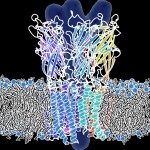Link to Pubmed [PMID] – 33973782
Link to HAL – Click here
Link to DOI – 10.1021/acs.jpcb.1c02658
J Phys Chem B. 2021 May 20;125(19):5052-5067.
We present an extension of the Poisson-Boltzmann model in which the solute of interest is immersed in an assembly of self-orienting Langevin water dipoles, anions, cations, and hydrophobic molecules, all of variable densities. Interactions between charges are controlled by electrostatics, while hydrophobic interactions are modeled with a Yukawa potential. We impose steric constraints by assuming that the system is represented on a cubic lattice. We also assume incompressibility; i.e., all sites of the lattice are occupied. This model, which we refer to as the Hydrophobic Dipolar Poisson-Boltzmann Langevin (HDPBL) model, leads to a system of two equations whose solutions give the water dipole, salt, and hydrophobic molecule densities, all of them in the presence of the others in a self-consistent way. We use those to study the organization of the ions, cosolvent, and solvent molecules around proteins. In particular, peaks of densities are expected to reveal, simultaneously, the presence of compatible binding sites of different kinds on a protein. We have tested and validated the ability of HDPBL to detect pockets in proteins that bind to hydrophobic ligands, polar ligands, and charged small probes as well as to characterize the binding sites of lipids for membrane proteins.


